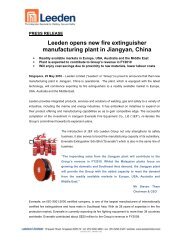Annual Report 2010 - Leeden Limited
Annual Report 2010 - Leeden Limited
Annual Report 2010 - Leeden Limited
Create successful ePaper yourself
Turn your PDF publications into a flip-book with our unique Google optimized e-Paper software.
Notes to the Financial Statementsfor the Financial Year ended 31 December <strong>2010</strong><strong>Leeden</strong> <strong>Limited</strong> <strong>Annual</strong> <strong>Report</strong> <strong>2010</strong>2. Summary of significant accounting policies (cont’d)2.4 Basis of consolidationBusiness combinations from 1 January <strong>2010</strong>The consolidated financial statements comprise the financial statements of the Company and its subsidiaries as at theend of the reporting period. The financial statements of the subsidiaries used in the preparation of the consolidatedfinancial statements are prepared for the same reporting date as the Company. Consistent accounting policies are appliedto like transactions and events in similar circumstances.All intra-group balances, income and expenses and unrealised gains and losses resulting from intra-group transactions areeliminated in full.Subsidiaries are consolidated from the date of acquisition, being the date on which the Group obtains control, and continueto be consolidated until the date that such control ceases.Business combinations are accounted for by applying the acquisition method. Identifiable assets acquired and liabilitiesassumed in a business combination are measured initially at their fair values at the acquisition date. Acquisition-relatedcosts are recognised as expenses in the periods in which the costs are incurred and the services are received.When the Group acquires a business, it assesses the financial assets and liabilities assumed for appropriate classificationand designation in accordance with the contractual terms, economic circumstances and pertinent conditions as at theacquisition date. This includes the separation of embedded derivatives in host contracts by the acquiree.Any contingent consideration to be transferred by the acquirer will be recognised at fair value at the acquisition date.Subsequent changes to the fair value of the contingent consideration which is deemed to be an asset or liability, willbe recognised in accordance with FRS 39 either in profit or loss or as change to other comprehensive income. If thecontingent consideration is classified as equity, it is not be remeasured until it is finally settled within equity.In business combinations achieved in stages, previously held equity interests in the acquiree are remeasured to fair valueat the acquisition date and any corresponding gain or loss is recognised in profit or loss.The Group elects for each individual business combination, whether non-controlling interest in the acquiree (if any) isrecognised on the acquisition date at fair value, or at the non-controlling interest’s proportionate share of the acquireeidentifiable net assets.Any excess of the sum of the fair value of the consideration transferred in the business combination, the amount of noncontrollinginterest in the acquiree (if any), and the fair value of the Group’s previously held equity interest in the acquiree(if any), over the net fair value of the acquiree’s identifiable assets and liabilities is recorded as goodwill. The accountingpolicy for goodwill is set out in Note 2.11(a). In instances where the latter amount exceeds the former, the excess isrecognised as gain on bargain purchase in profit or loss on the acquisition date.Business combinations before 1 January <strong>2010</strong>In comparison to the above mentioned requirements, the following differences applied:Business combinations are accounted for by applying the purchase method. Transaction costs directly attributable to theacquisition formed part of the acquisition costs. The non-controlling interest (formerly known as minority interest) wasmeasured at the proportionate share of the acquiree’s identifiable net assets.Business combinations achieved in stages were accounted for as separate steps. Adjustments to those fair values relatingto previously held interests are treated as a revaluation and recognised in equity.When the Group acquired a business, embedded derivatives separated from the host contract by the acquiree are notreassessed on acquisition unless the business combination results in a change in the terms of the contract that significantlymodifies the cash flows that would otherwise be required under the contract.Contingent consideration was recognised if, and only if, the Group had a present obligation, the economic outflow wasmore likely than not and a reliable estimate was determinable. Subsequent measurements to the contingent considerationaffected goodwill.49





